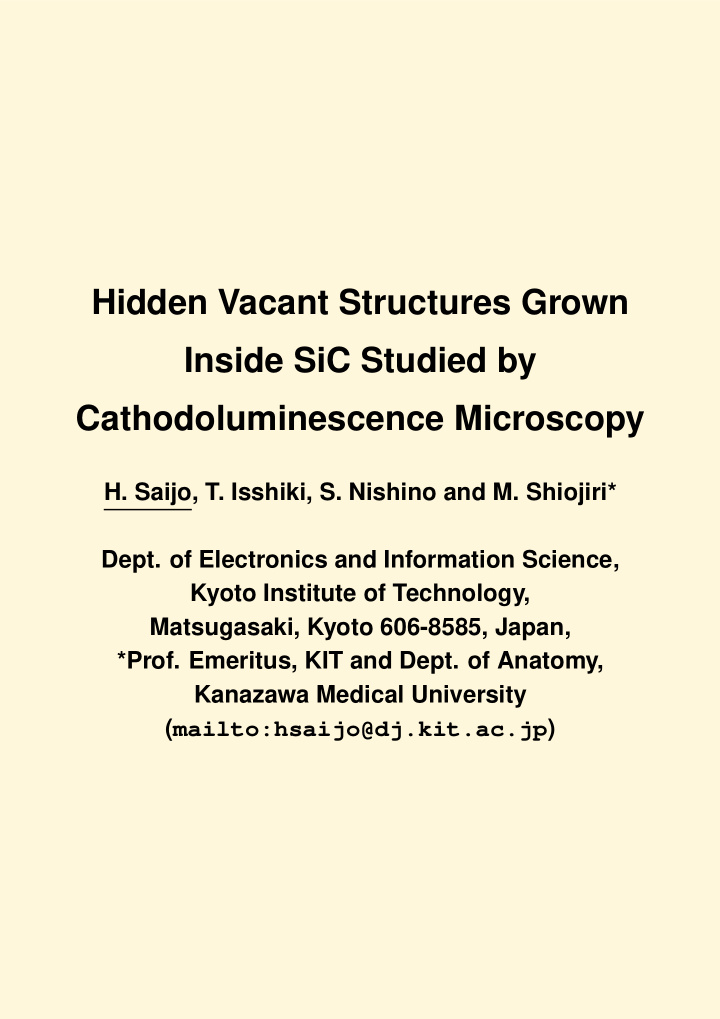



Hidden Vacant Structures Grown Inside SiC Studied by Cathodoluminescence Microscopy H. Saijo, T. Isshiki, S. Nishino and M. Shiojiri* Dept. of Electronics and Information Science, Kyoto Institute of Technology, Matsugasaki, Kyoto 606-8585, Japan, *Prof. Emeritus, KIT and Dept. of Anatomy, Kanazawa Medical University ( mailto:hsaijo@dj.kit.ac.jp )
Fig. 1 A schematic diagram of our CL microscope. Extensively reconstructed by us on the basic system developed by H. Koike [1, 2] . Fig. 2 ( right ) Color reproduction of the present CL system reconstructed with the reflection-transmission data of dichroic mirrors.
Fig. 3 Micropipe of SiC found on as diced plane. a : SEM, b : CL and c : AFM images of the pipe that is partly cut opened when dicing. c is the area in the oval in b . White line in a and red line in b (pointed by arrows) is hidden part of the pipe.
Cathodoluminescence (CL) Microscopy visualizes local structures with different electronic structures from the surround- ings (bulk). The color and the intensity display the distribution and population of the structure grown on the surface or inside including defects, lattice dis- tortion, adsorption, electronic excited area, etc. Steps, kinks and facets are another candidate of CL emission. Poly- morph, a new crystal structure growth, shows new electronic structure. Fig. 4 ( left ) Micropipe inside and deformations during fabrication of SiC are reproduced in different color in the CL micrographs. By varying the acceleration voltage of incident beam, the structure at different depth can be imaged selectively.
In the semiconductor technology, the specimen crystals are expected to be highly homogeneous except the inten- tionally introduced structures in the fab- rication process, and the evaluation of density and distribution of foreign structures grown inside are highly re- quired for the qualified manufacturing process. The hidden structures grown inside can be imaged with varying incident elec- tron energy. The wavelength and in- tensity in CL micrographs corresponds to the electronic structures of the spec- imen, and the variation of the wave- length means local electronic states created by some change of atomic ar- rangements.
The CL micrograph is thus a map of distribution of electronic structure or states of the specimen. We took CL micrographs with three-band CL micro- scope that provides full color image of CL emitting sources in the specimen with some spectrometric accuracy. This paper deals some typical local structures found inside ceramic semi- conductors and II-IV semiconductors. Defects, impurity distributions and lat- tice distortion, display color variations in CL micrographs to disclose their po- sition, distribution and population.
Fig. 6 Top View of the hexagonal cavity. SEM im- age shows openings of micropipes aligning linearly along the edge.
Fig. 5 Hexagonal cavities grown inside SiC. The upper cavity contains some crystal growth on the bottom, while the lower shows highly developed growth inside the cavity. On the bottom, there are many small holes, presum- ably opening of micropipes. References [1] H. Koike, T. Nakano, T. Fujimoto and K. Ogawa, “Proc. EUREM88”, 3 , 591 (1988) [2] T. Nakano, T. Fujimoto, H. Koike and K. Ogawa, Acta Histochem. Cytochem. 23 , 753-767 (1990)
Recommend
More recommend